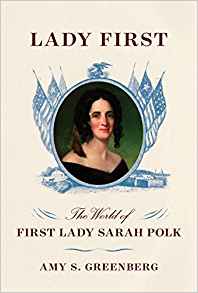Lady First: The World of First Lady Sarah Polk
- By Amy S. Greenberg
- Knopf
- 400 pp.
- Reviewed by Paula Tarnapol Whitacre
- March 27, 2019
A pre-Civil War political spouse recognizes the power of her position.

As Americans purchase gazillions of copies of Michelle Obama’s memoir and endlessly speculate about Melania Trump’s fashion choices, it’s clear that we are fascinated with first ladies. Sarah Childress Polk, the wife of the 11th president, pioneered the cult of the position, or, as historian Amy S. Greenberg notes in Lady First: The World of First Lady Sarah Polk, “Sarah Polk understood the symbolic power of her position in a manner that her predecessors had not.”
While not all subsequent first ladies did the same, she was “the first politically effective partisan First Lady, in a period when the role of women was strictly circumscribed.”
Greenberg, a professor of history and women’s studies at Penn State, has published previous books about the 1840s, when Manifest Destiny — the belief that white Americans were “destined” to occupy the whole of North America — was on the rise. She brings this broader understanding to her study of Sarah and James Polk before and after his presidency, as well as during his one term in office (1845-1849).
Sarah Childress was born in 1803 in Murfreesboro, Tennessee’s capital during her young womanhood. Her politically connected father sent her to a school in North Carolina for an education she could not get as a female back home, a shocking move for the day.
Although his death cut short her schooling, “Her time at Salem Academy profoundly shaped Sarah Childress,” writes Greenberg. Throughout her life, she valued reading and confidently conversed and corresponded with the political elite in Tennessee and in Washington.
James was one of the young men drawn to the Childress parlor, and he and Sarah married in 1823. While he already had some political ambitions, Greenberg makes clear that he would not have become a congressman, speaker of the House of Representatives, state governor, or, ultimately, president of the United States, without Sarah.
In fact, he comes off in the biography as a bit of a nebbish, and a nagging one at that. Sarah became James’ advisor, advance person, public-relations expert, gatekeeper, cheerleader, and just about every other role that a successful politician requires — of course, unpaid, and with no formal title.
He clearly valued and relied on her insights and energy, which seemed far better honed than his. Yet, he sent a stream of letters while out on the campaign trail with demands to perform this task or that, with nary a “thank you” or “job well done.”
Greenberg makes clear that two circumstances allowed Sarah the time to devote to politics and James’ career. First, while the Polks took in various nieces and nephews, often for quite lengthy periods, they had no children of their own. Thus, Sarah was spared the near-constant pregnancy/childbirth/motherhood cycle that characterized the lives of her female friends and family members for literally decades.
Second, enslaved people took care of the domestic duties in the household and provided income on land that James owned in Tennessee and Mississippi. Greenberg documents Sarah’s self-belief as a “good slavemistress,” yet, more relevantly, compares the mortality rates on the Polk plantation in Mississippi with those of neighboring properties. Even for the notoriously inhumane cotton plantations of the Deep South, the Polk slaves fared worse than most.
Greenberg also investigates any connections between Sarah Polk and the Seneca Falls activists, including Elizabeth Cady Stanton, who gathered to produce the “Declaration of Sentiments” the same year that Polk was elected.
“There is no evidence that Sarah or James took an interest in the events in upstate New York,” Greenberg states, but “she clearly supported less radical reforms to women’s economic status.” She walked a fine line, publicly embracing the ideal of true womanhood of the era while “providing cover for outsized political power that was not nearly as deferential as it appeared.”
James spent most of his term as commander-in-chief daydreaming about his post-presidency years, but he died shortly after leaving office at age 53. Sarah was 45 at the time and “saw no path forward, no purpose for continuing.”
After several years of deep mourning, however, she began to create a new role for herself. She held court in a grand house in Nashville during the Civil War, Reconstruction, and re-emergence of institutional racism toward the end of the century.
In fact, Sarah lived until 1891, a widow almost twice as long as a wife. She took advantage of her status as a former first lady, using it to protect herself and her family even when the Union occupied Nashville.
Never a drinker or dancer for religious reasons, she became very involved with the Women’s Christian Temperance Union and its leader, Frances Willard. Willard admired Sarah, but, as Greenberg notes, “she also recognized that Sarah’s stature in the South could prove useful to building support for the temperance movement among southern white women.”
Greenberg’s use of an array of primary sources, built on her understanding of mid-19th-century America, provides a strong accounting of a complex woman. I didn’t know anything about Sarah Polk before I read this biography and, to be honest, didn’t particularly like her afterward.
I do suspect, though, that had she lived in a more recent time, she would’ve been the professional politician in the family while James enjoyed the mansion back in Nashville.
Paula Tarnapol Whitacre is the author of A Civil Life in an Uncivil Time: Julia Wilbur’s Struggle for Purpose and is continuing to research 19th-century women for a forthcoming group biography.

